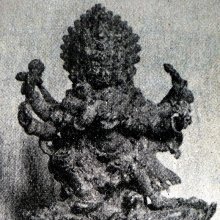Odiyana, Oḍiyāna: 5 definitions
Introduction:
Odiyana means something in Buddhism, Pali, Hinduism, Sanskrit. If you want to know the exact meaning, history, etymology or English translation of this term then check out the descriptions on this page. Add your comment or reference to a book if you want to contribute to this summary article.
Images (photo gallery)
In Hinduism
Shaktism (Shakta philosophy)
Source: Google Books: ManthanabhairavatantramOḍiyāṇa (ओडियाण) is another name for Oḍḍiyāna, which refers to a Mahāpīṭha (main sacred seat) and one of the ten places visited by the Goddess on her pilgrimage, according to Tantric texts such as the Kubjikāmata-tantra, the earliest popular and most authoritative Tantra of the Kubjikā cult.—Accordingly, “[...] Then content and profound, Kujeśvarī who is endowed with the quality of discernment and whose creation (takes place) by many means said this: “As (I) have flown up (oḍḍitā) (here) within Oḍḍīśa, therefore this (place will be known) as Oḍḍiyānaka”.

Shakta (शाक्त, śākta) or Shaktism (śāktism) represents a tradition of Hinduism where the Goddess (Devi) is revered and worshipped. Shakta literature includes a range of scriptures, including various Agamas and Tantras, although its roots may be traced back to the Vedas.
In Buddhism
Tibetan Buddhism (Vajrayana or tantric Buddhism)
Source: archive.org: The Indian Buddhist IconographyOḍiyāna (ओडियान) is another name for Uḍḍiyāna, which refers to one of the four pīṭhas (sacred spots) according to the Sādhanamālā.—It is difficult to say from what exact locality Tantrism took its origin. In the Sādhanamālā are mentioned the four Pīṭhas or sacred spots of the Vajrayānists, namely, Kāmākhyā, Sirihaṭṭa, Pūrṇagiri and Uḍḍiyāna. [...] The Sādhanamālā also connects Uḍḍiyāna with such Tantric authors as Saraha. The Jñānasiddhi of Indrabhūti is stated in the last colophon as having started from Uḍḍiyāna (Oḍiyāna).
Source: OSU Press: Cakrasamvara SamadhiOḍiyāna (ओडियान) is the pīṭha associated with Prabhāmatī and Kaṅkāla, according to the Cakrasaṃvara-maṇḍala or Saṃvaramaṇḍala of Abhayākaragupta’s Niṣpannayogāvalī, p. 45 and n. 145; (Cf. Cakrasaṃvaratantra, Gray, David B., 2007).—The Cakrasaṃvara mandala has a total of sixty-two deities. [...] Three concentric circles going outward, the body, speech and mind wheels (kāya-vāka-citta), in the order: mind (blue), speech (red), and body (white), with eight Ḍākinīs each in non-dual union with their Ḍākas, "male consorts".
Associated elements of Prabhāmatī and Kaṅkāla:
Circle: kāyacakra (mind-wheel) (blue);
Ḍākinī (female consort): Prabhāmatī;
Ḍāka (male consort): Kaṅkāla;
Bīja: oṃ;
Body-part: right ear;
Pīṭha: Oḍiyāna;
Bodily constituent: tvaṅ-mala (skin/filth);
Bodhipakṣa (wings of enlightenment): mīmāṃsā-ṛddhipāda (power of analysis).

Tibetan Buddhism includes schools such as Nyingma, Kadampa, Kagyu and Gelug. Their primary canon of literature is divided in two broad categories: The Kangyur, which consists of Buddha’s words, and the Tengyur, which includes commentaries from various sources. Esotericism and tantra techniques (vajrayāna) are collected indepently.
Languages of India and abroad
Sanskrit dictionary
Source: Cologne Digital Sanskrit Dictionaries: Edgerton Buddhist Hybrid Sanskrit DictionaryOḍiyāna (ओडियान).—see Oḍḍi°.
Sanskrit, also spelled संस्कृतम् (saṃskṛtam), is an ancient language of India commonly seen as the grandmother of the Indo-European language family (even English!). Closely allied with Prakrit and Pali, Sanskrit is more exhaustive in both grammar and terms and has the most extensive collection of literature in the world, greatly surpassing its sister-languages Greek and Latin.
Kannada-English dictionary
Source: Alar: Kannada-English corpusOḍiyāṇa (ಒಡಿಯಾಣ):—[noun] an encircling band of metal, esp. of gold or silver, for a woman’s waist; a girdle.
Kannada is a Dravidian language (as opposed to the Indo-European language family) mainly spoken in the southwestern region of India.
See also (Relevant definitions)
Starts with: Odiyanapitha.
Full-text (+10): Oddiyana, Odu, Om, Bijoddhara, Indravarini, Mudrapitha, Odamba, Prabhamati, Mimamsa, Adharisa, Kankala, Mala, Simha, Tvac, Mimamsarddhipada, Uddiyana, Agnimukha, Vijamba, Khecarimudra, Oda.
Relevant text
Search found 2 books and stories containing Odiyana, Oḍiyāna, Oḍiyāṇa; (plurals include: Odiyanas, Oḍiyānas, Oḍiyāṇas). You can also click to the full overview containing English textual excerpts. Below are direct links for the most relevant articles:
The Indian Buddhist Iconography (by Benoytosh Bhattachacharyya)
Blue Annals (deb-ther sngon-po) (by George N. Roerich)
Chapter 2b - Kyungpo Naljor disciples (iv): sangs rgyas ston pa < [Book 9 - Kodrakpa and Niguma]
